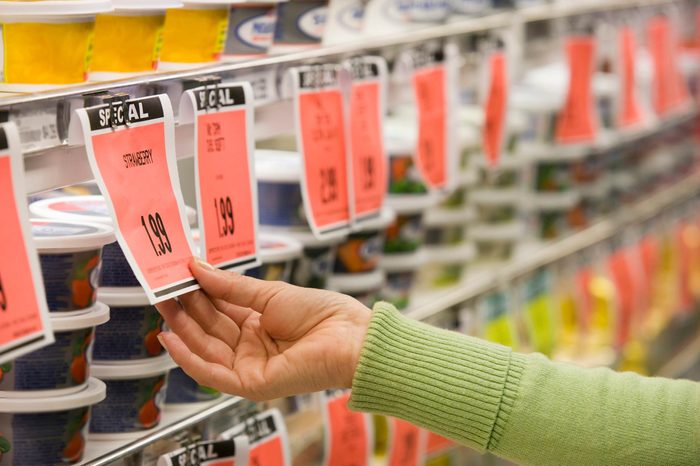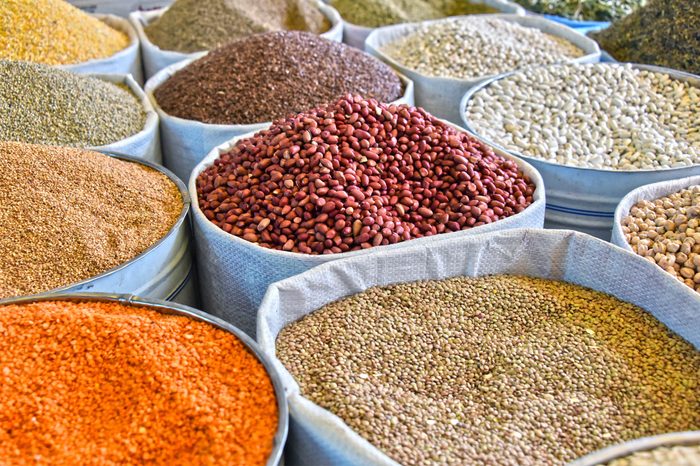
Buy in bulk
Especially if you have a big family or lots of freezer space, one of the best ways to save money at the supermarket is to bypass it entirely and shop instead at large wholesale stores like Costco or B.J.’s. The prices are typically cheaper (especially for things like nuts), but some aren’t, so make sure to know about how much you’d pay at the supermarket. If your family can’t plow through 24 eggs in one week, plan to split the cartons—and the cost, with a friend or neighbor.

Join a CSA
Another way to stretch your grocery dollar is to join a local CSA or Community Supported Agriculture Association in your area. You’ll get fresher, less expensive produce, and help local farmers at the same time. By paying a certain amount of money along with other members in the association, you are keeping the farmer in business and reaping the benefits of their fresh crop. You are also reducing your carbon footprint by buying locally. Better still, your veggies and fruits will have more nutrients because they’re fresher and not being flown or trucked in from thousands of miles away.

Rethink one-stop-shopping
Being more thoughtful about where you shop can make a huge impact on your grocery bill. Make an effort to price check at the various local supermarkets, because even within the same zip code, some may be twice as pricey as others. Avoid specialty shops, where food is usually more expensive, or only use them on special occasions or in a pinch. This may mean you need to plan your shopping trips a bit more strategically—packaged foods from one market and fresh foods or exotic ingredients from another—but your wallet will thank you. Don’t miss these 19 tips frugal shoppers use to save on groceries.

Rediscover healthy basics
Another way to save money when shopping is to buy cheaper (but still healthy!) foods for yourself and your family. Have you been eating a lot of fresh tuna, filet mignon, and organic radicchio? Consider that you could save hundreds of dollars a month by making eggs for dinner, cooking lentil soup for lunch, and adding canned tuna to salad for a delicious dinner. All of these items are inexpensive and packed with nutrients. It’s also a great way to expose children to new foods.

Shop the sales
Making a concerted effort to only buy items on sale at the grocery store is a surefire way to save big. Why buy farmed salmon for $12 a pound when organic salmon is on sale for $10 a pound? Walking the aisles, checking out the circulars, and noticing which items are reduced that week can save you a surprising amounts of money. You can also take advantage of apps that do the math for you: Favado will show you what’s on sale at your favorite stores and compare prices between stores, so you can build your weekly menu accordingly. Grocery Pal will store your top shopped-for items, compare their prices at stores near you, and prompt you to print any available coupons.

Team up
Creating a shopping co-op with your friends can save you money as well because you won’t always have to spend money on gas or a babysitter if you need one. Making arrangements with friends or neighbors to give and get lists when you shop at various supermarkets can actually reduce your overall shopping costs over time. Just be as specific as possible when you want a certain type, size, or brand of the items. Creating bulk-buying co-ops with friends and family can make big-box shopping work for you.

Don’t pay for kid-sitting
Creating a babysitting co-op is another great way to save money on your grocery bill. Enlisting friends to watch your children while you shop can save money on babysitting if you would otherwise require childcare when shopping. But don’t forget you’ll have to watch their kids some time in the future, too!

Don’t fear the frozen aisle
Fresh produce seems superior to frozen, but it isn’t always—and it’s often cheaper. Because frozen foods are typically frozen immediately after picking, they retain most of their nutrients. Believe it or not, fresh vegetables that have traveled from far away may have lost more nutrients than the fresh-picked frozen ones. For example, frozen spinach is a better value than fresh. Here are 50 insider secrets to save at your favorite stores.

Go ethnic
Combine family outings with shopping trips at ethnic supermarkets, like those in Asian, Indian, Italian, African, and Middle Eastern enclaves. Many ethnic markets tend to be less expensive—you’ll find savings on everything from pasta, rice, and tortillas to tea, coffee, and vegetables. And a a bonus, children get exposed to other cultures. Also, if you are already in an area having lunch or going to the circus (lucky day), you save time and money on gas because you have planned ahead and don’t have to make an extra trip to get food.

Forget fancy labels
Don’t get suckered by brand-name advertising. Americans waste some $44 billion a year on name brands instead of getting nearly the exact same stuff using cheaper store brands, according to CNN Money. Buying generic items is a great way to shave dollars off your grocery bill when it comes to certain items, like paper napkins, laundry detergent, or ingredients like salt, sugar, and baking powder. Certain aspirin and ibuprofen brands have the exact same ingredients as the name brands but cost much less.